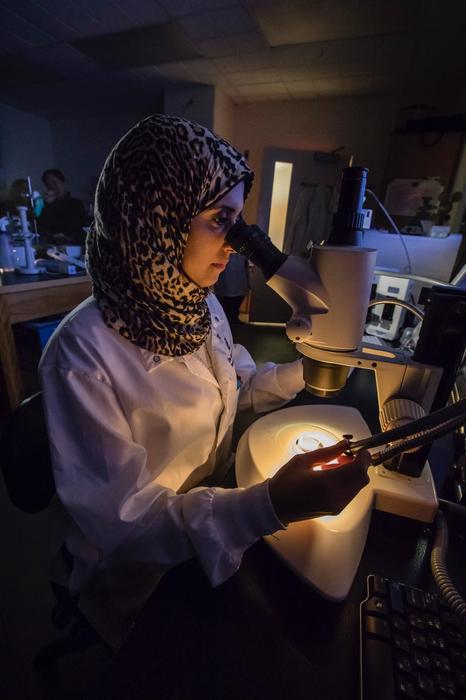New Mapping Reveals Unmatched Details of Neural Connections and Visual Perception in Mouse Brains
In an extraordinary scientific breakthrough, researchers operating under the auspices of the National Institutes of Health (NIH) have successfully mapped the intricate web of connections between hundreds of thousands of neurons in the mouse brain. This comprehensive initiative, known as the Machine Intelligence from Cortical Networks (MICrONS) Program, represents a collaborative endeavor involving hundreds of […]


In an extraordinary scientific breakthrough, researchers operating under the auspices of the National Institutes of Health (NIH) have successfully mapped the intricate web of connections between hundreds of thousands of neurons in the mouse brain. This comprehensive initiative, known as the Machine Intelligence from Cortical Networks (MICrONS) Program, represents a collaborative endeavor involving hundreds of scientists who have painstakingly reconstructed a subset of neurons, aiming to elucidate the mechanisms underlying visual information processing in the brain. By doing so, they are uncovering the fundamental principles that govern how we perceive and interpret the world around us.
The research, which has been likened to the unveiling of a digital map of the brain’s connectivity, provides unprecedented insights into how information is transmitted through the neural circuits of mice. By employing advanced imaging techniques, the team was able to optically capture the firing patterns of specially engineered neurons that emit light upon activation, shedding light on the functional dynamics of the visual cortex. This intricate mapping is crucial because it serves as the foundation for a broader understanding of how brains, including our own, interpret visual stimuli.
At the heart of this endeavor lies the ongoing quest to unravel the complex signaling pathways that govern neuronal communication. The human brain, with its approximately 86 billion neurons and trillions of synaptic connections, exhibits a level of intricacy that can obscure the fundamental processes behind cognition and behavior. The findings from this research are pivotal because they begin to illuminate the cellular phenomena that allow for sensory perception, revealing the enigmatic symphony of electrical activity that underpins our conscious experience.
Researchers meticulously cut and imaged ultra-thin slices of brain tissue, employing electron microscopy for high-resolution visualization. This rigorous process involved lengthy 12-hour shifts over a span of 12 consecutive days, reflecting the dedication required to gather the massive amounts of data necessary for this project. More than 500 million synapses were effectively mapped across 200,000 cells, all within an area equivalently sized to a grain of sand. The result is a vivid tapestry of neural connectivity that offers insights into the operational framework of vision-related brain regions.
The enormous volume of data produced during this study is staggering. At 1.6 petabytes, it is akin to 22 years of continuous HD video, highlighting the sheer scale of the undertaking. Following the collection phase, researchers faced the daunting task of reconstructing the data into a coherent framework. This step involved the painstaking stitching together of nearly 28,000 high-resolution images of brain tissue, ensuring that each connection was accurately represented and aligned within the complex three-dimensional structure of the brain.
The application of deep learning algorithms played a critical role in the analysis of this neural data. These computational models were developed to predict how the visual cortex processes information, and they underwent rigorous validation processes, including manual and automated proofreading. Such advanced methodologies underscore the intersection of biology and technology in modern neuroscience, where machine learning tools augment our understanding of brain function.
As maps of neuronal connections become increasingly sophisticated, they reveal the underlying patterns and structures that define neural communication. Recent initiatives funded by the NIH, including the Brain Research Through Advancing Innovative Neurotechnologies (BRAIN) Initiative, have expanded the horizons of neuroanatomical research. Notably, the first complete cell atlas of the mouse brain was produced in 2023, cataloging over 32 million cells. This kind of comprehensive mapping is facilitating novel insights into not just how brains function in health, but also how they succumb to pathology.
The funding for this groundbreaking research has been made possible through a collaboration of agencies, with the NIH BRAIN Initiative playing a pivotal role. Over seven years, more than 150 scientists have contributed their expertise, cumulatively enhancing our understanding of complex neural architectures. This research is not merely academic; it has profound implications for finding new treatments for neurological diseases and disorders by illuminating the workings of a healthy brain.
The integrate-and-interpret approach of this project offers a hopeful narrative for those investigating the future of neuroscience. By producing visualizations that facilitate the exploration of connectomic data online, the MICrONS program is enabling a broader audience—researchers, clinicians, and the public—to engage with the science. The impact of this work resonates beyond academia; it permeates the societal understanding of neurological health and the biological substrates of behavior.
As we harness this knowledge, we are not just spectators of scientific advancement but active participants in the unfolding narrative of brain research. The convergence of various disciplines—biology, technology, neuroscience, and artificial intelligence—continues to redefine our expectations for the future of health and medicine. As researchers delve deeper into the intricate mappings unveiled by the MICrONS project, the hope remains that these foundational discoveries will lead to transformative treatments that enhance human health and well-being.
In conclusion, this mapping initiative represents a quantum leap toward a comprehensive understanding of the neuron networks that serve as the bedrock of cognition. The 21st century is witnessing the dawn of a new era in neuroscience, fueled by the collaborative efforts of countless researchers who are united in their pursuit of knowledge. As they puzzle together the threads of neural connectivity, they offer a promising path forward in the quest to decode the complexities of the human brain.
Subject of Research: Animals
Article Title: Inhibitory specificity from a connectomic census of mouse visual cortex.
News Publication Date: 9-Apr-2025
Web References: NIH BRAIN Initiative
References: Nature Scientific Journal
Image Credits: The Allen Institute
Keywords: Public health, Neuroscience, Visual Cortex, Neuron Mapping, Brain Connectivity, Deep Learning, Machine Intelligence.
Tags: advanced imaging techniquesbrain connectivity insightsfunctional dynamics of the visual cortexMachine Intelligence from Cortical Networksmouse brain researchneural connections mappingneuronal firing patternsNIH neuroscience initiativesignaling pathways in neuroscienceunderstanding brain interpretation of stimulivisual information processingvisual perception mechanisms
What's Your Reaction?

































